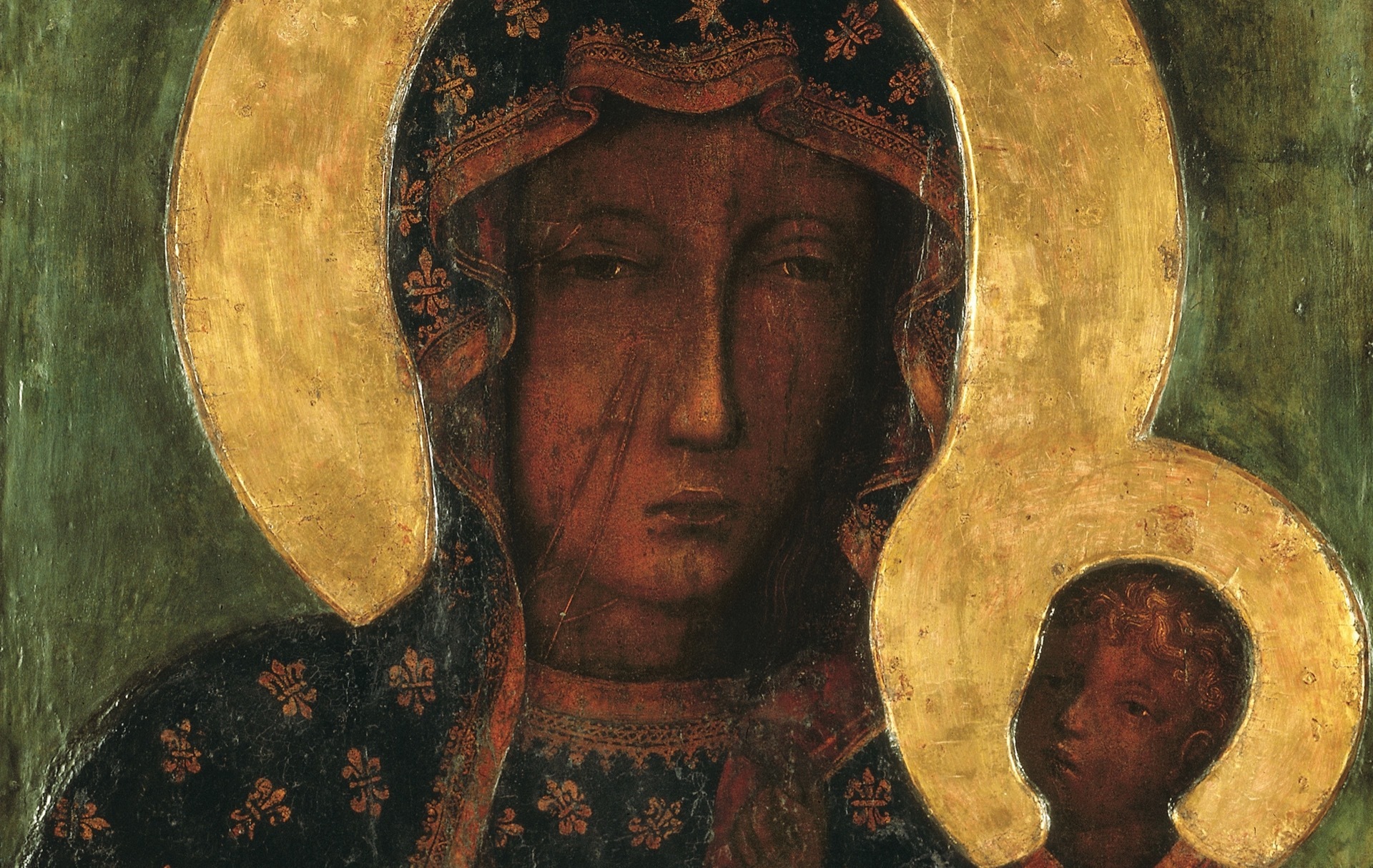This is translated from Polish that appeared on jasnagora.com under Source materials and scientific studies. It was written by O. Jan Stanislaw Rudzinski OSPPE.

The magnificent ceremony of the solemn unveiling or veiling of the Miraculous Picture of Our Lady of Jasna Gora delights the praying pilgrims. The silver veil is raised or lowered to the sound of fanfare played by the Pauline ensemble of trumpeters. It is very illuminated, but it isn’t easy to read its iconographic message. Let us, therefore, try to discover the full richness of the ideological message of this composition. According to Father Jan Golonka, a Pauline priest and curator of Votive Art at Jasna Gora, the silver, partly gilded sheet is composed of two parts: a silver frame-bordering and a sheet filling it with an allegorical representation referring to the Immaculate Conception of the Mother of God. The silver frame-bordering was donated in 1675 by Katarzyna and Zygmunt Dzialynski. It was made in 1673 by goldsmith Johann Leman. Initially, it framed the curtains with which the Picture was covered. Later, in 1723, it became the border of the veil of the Miraculous Picture of Our Lady. In the middle of the upper part of the frame, composed of six interconnected silver plates, in an oval medallion is the Latin inscription: SCANDITE MORTALES ALTA CACUMINA MONTIS HIC UOBIS CUNCTIS FACTA MARIA SALUS, which reads in translation: Ascend, mortals, to the high peaks of the mountains; it is here that Mary has become the salvation for you all. A large part of the lower moulding is occupied by a rhymed votive inscription in an oval cartouche:
QUEEN OF CZĘSTOCHOWA MOTHER OF GOD OF MOUNTAINS
AND HOW RICH YOU ARE,
MOTHER OF ALL THE MOUNTAINS
ALL MY HOME PROCLAIM THEE ITS QUEEN
MAY YOUR SON CARRY IT IN HIS PROTECTION.
The author of the apostrophe to the Mother of God was probably the donor of the bordure frame – Zygmunt Działyński. The date of the execution of the border, “A. D. 1673”, is placed under the poem. Both reproduced inscriptions were created on earlier inscriptions made with punctuation. In the upper part of the cartouche, above the Old Polish text, there are traces of illegible letters and even whole words made with a stylus. On the cartouche moulding, with the Latin inscription in its central upper and lower parts, there is an ornamental motif of ‘snake skin’, repeated three times among the rich floral trail of the border. The medallion with the votive inscription is supported by cherubs seated on spheres, resting the other hand on obliquely placed shields in cartouche frames with the founders’ coats of arms: on the left, the Coat of Arms of the Działyński family and on the right the Motto of the Witosławski family. Ambroży Nieszporkowicz, a Pauline priest, informs us about the donation of the frame in 1675 in his work written in prose and verse in honour of Saints Honorat and Kandyda on the occasion of the celebrations of the three-hundredth anniversary of the presence of the Miraculous Picture of the Mother of God in the Jasna Gora Monastery.
After the theft of several votive offerings from the altar of Our Lady on 1 July 1722, a bolt was introduced the following year, filling the frame of the Działyński foundation. The slider is a repoussé late Baroque relief, enriched with texturing and partial gilding. It presents an outstanding iconographic depiction of the Immaculate Conception of the Blessed Virgin Mary. The composition is divided into two iconographically different zones. The lower, earthly one depicts the drama of the fall of humanity resulting from original sin but also the hope of redemption. This is represented by the half figures of primordial creatures emerging from the earth. Eve holds a pomegranate – the fruit of sin, while Adam lifts up grapes – the fruit of redemption. The grapes are filled with an enamel medallion, with an iconographic representation of Christ on the cross, conquering death and the dragon – Satan – against a blue background. Behind the first parents, the tree of paradise of good and evil with a serpent wrapped around the trunk is visible in the background. On the sides, the lower part of the composition is occupied by the monumental figures of Mary’s parents, St Joachim and St Anne, from whose hearts grow lilies, joined in the middle by a common flower with large feathery and twisted petals. At the junction of the stems sits a jewel made in gold casting, decorated with rubies, representing a pelican. From the unfurled calyx of the lily in the upper zone of the composition emerges the figure of the Virgin Mary as the Apocalyptic Virgin, vanquishing Satan, who, as a serpent, hangs entwined on the moon’s sickle. The Blessed Virgin raises her right hand with an orant gesture. Her left hand supports the stem of a lily in which the infant Jesus – Emmanuel – is seated in a blooming flower, making a gesture of blessing. Above Mary’s head floats a radiant dove – a symbol of the Holy Spirit. To the right of the Holy Virgin, God the Father – Creator of the world – emerges from the clouds, supported by a globe, and together with His Son blesses the Chosen Heavenly One. The glory of the Virgin Mary is emphasised by a multitude of angels showing their winged heads and hovering on feathery clouds. Two angels hold scrolls with inscriptions: to the right of the Virgin Mary – Tota pulchra es Maria – All beautiful thou art, Mary; to the left – Et macula originalis non est in te – And the original stain is not in thee.
To sum up this description of the veil of the Miraculous Picture of Our Lady, it must be said that it is characterised by great iconographical richness and stands on the highest artistic level.


